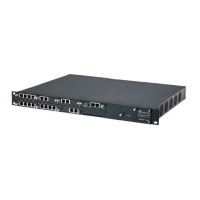Version 6.6 647 October 2014
Installation & Operation Manual 40. General SIP Configuration
The table below shows an example for configuring AD-based Tel-to-IP routing rules in
the Outbound IP Routing Table:
Table
40-28: AD-Based Tel-to-IP Routing Rule Configuration Examples
Index Dest. Phone Prefix Dest. IP Address
1 PRIVATE: 10.33.45.60
2 PBX: 10.33.45.65
3 OCS: 10.33.45.68
4 MOBILE: 10.33.45.100
5 LDAP_ERR 10.33.45.80
6 * LDAP
7 * 10.33.45.72
The table below shows an example for configuring AD-based SBC routing rules in the
IP-to-IP Routing Table:
Table
40-29: AD-Based SBC IP-to-IP Routing Rule Configuration Examples
Index
Destination Username
Prefix
Destination Type
Destination
Address
1 PRIVATE: Dest Address 10.33.45.60
2 PBX: Dest Address 10.33.45.65
3 OCS: Dest Address 10.33.45.68
4 MOBILE: Dest Address 10.33.45.100
5 LDAP_ERR Dest Address 10.33.45.80
6 * LDAP
7 * Dest Address 10.33.45.72
The configured routing rule example is explained below:
Rule 1: Sends call to private telephone line (at 10.33.45.60) upon successful AD
query result for the private attribute.
Rule 2: Sends call to IP PBX (at 10.33.45.65) upon successful AD query result
for the PBX attribute.
Rule 3: Sends call to Lync client (i.e., Mediation Server at 10.33.45.68) upon
successful AD query result for the Lync attribute.
Rule 4: Sends call to user's mobile phone number (to PSTN through the device's
IP address at 10.33.45.100) upon successful AD query result for the Mobile
attribute.
Rule 5: Sends call to IP address of device (10.33.45.80) if AD query failure (e.g.,
no response from LDAP server or attribute not found).

